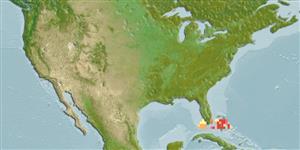Actinopterygii (ray-finned fishes) >
Ophidiiformes (Cusk eels) >
Bythitidae (Viviparous brotulas) > Brosmophycinae
Etymology: Lucifuga: Latin, lux = light + latin, fugere = to escape, to avoid, to run away from (Ref. 45335). More on author: Cohen, Robins.
Environment / Climate / Range
Ecology
Marine; brackish; demersal; depth range 1 - 21 m (Ref. 34024). Subtropical, preferred ?; 26°N - 24°N
Western Central Atlantic: Bahamas.
Size / Weight / Age
Maturity: Lm ? range ? - ? cm
Max length : 10.9 cm SL male/unsexed; (Ref. 13498)
Dorsal
soft rays
(total): 86-109;
Anal
soft rays: 66 - 82;
Vertebrae: 51 - 55. This species is distinguished from its congeners by the following combination of characters: Vertebrae 13-14+38-42=51-55, dorsal fin rays 86-109, anal fin rays 66-82, pectoral fin rays 17-20, caudal fin rays 10; head profile above eye is strongly depressed, small, developed eyes 0.7-1.8 % SL; palatine teeth present, in 1-7 short irregular rows, with 3-56 teeth total; long gill-rakers 3, dark pigmented (Ref. 57878).
Inhabits dark inland caves, brackishwater sinkholes, and marine blue holes (Ref. 27158. 57878).
Life cycle and mating behavior
Maturity | Reproduction | Spawning | Eggs | Fecundity | Larvae
Møller, P.R., W. Schwarzhans, T.M. Iliffe and J.G. Nielsen, 2006. Revision of the Bahamian cave-fishes of the genus Lucifuga (Ophidiiformes, Bythitidae), with description of a new species from islands on the Little Bahama Bank. Zootaxa 1223:23-46. (Ref. 57878)
IUCN Red List Status (Ref. 115185)
CITES (Ref. 94142)
Not Evaluated
Threat to humans
Harmless
Human uses
Fisheries: of no interest
More information
ReferencesAquacultureAquaculture profileStrainsGeneticsAllele frequenciesHeritabilityDiseasesProcessingMass conversion
Tools
Special reports
Download XML
Internet sources
Estimates of some properties based on models
Phylogenetic diversity index (Ref.
82805): PD
50 = 0.5078 [Uniqueness, from 0.5 = low to 2.0 = high].
Bayesian length-weight: a=0.00447 (0.00175 - 0.01142), b=3.10 (2.88 - 3.32), in cm Total Length, based on LWR estimates for this (Sub)family-body shape (Ref.
93245).
Trophic Level (Ref.
69278): 3.3 ±0.5 se; Based on size and trophs of closest relatives
Resilience (Ref.
69278): Very Low, minimum population doubling time more than 14 years (Assuming Fec < 10).
Vulnerability (Ref.
59153): Low vulnerability (22 of 100) .
